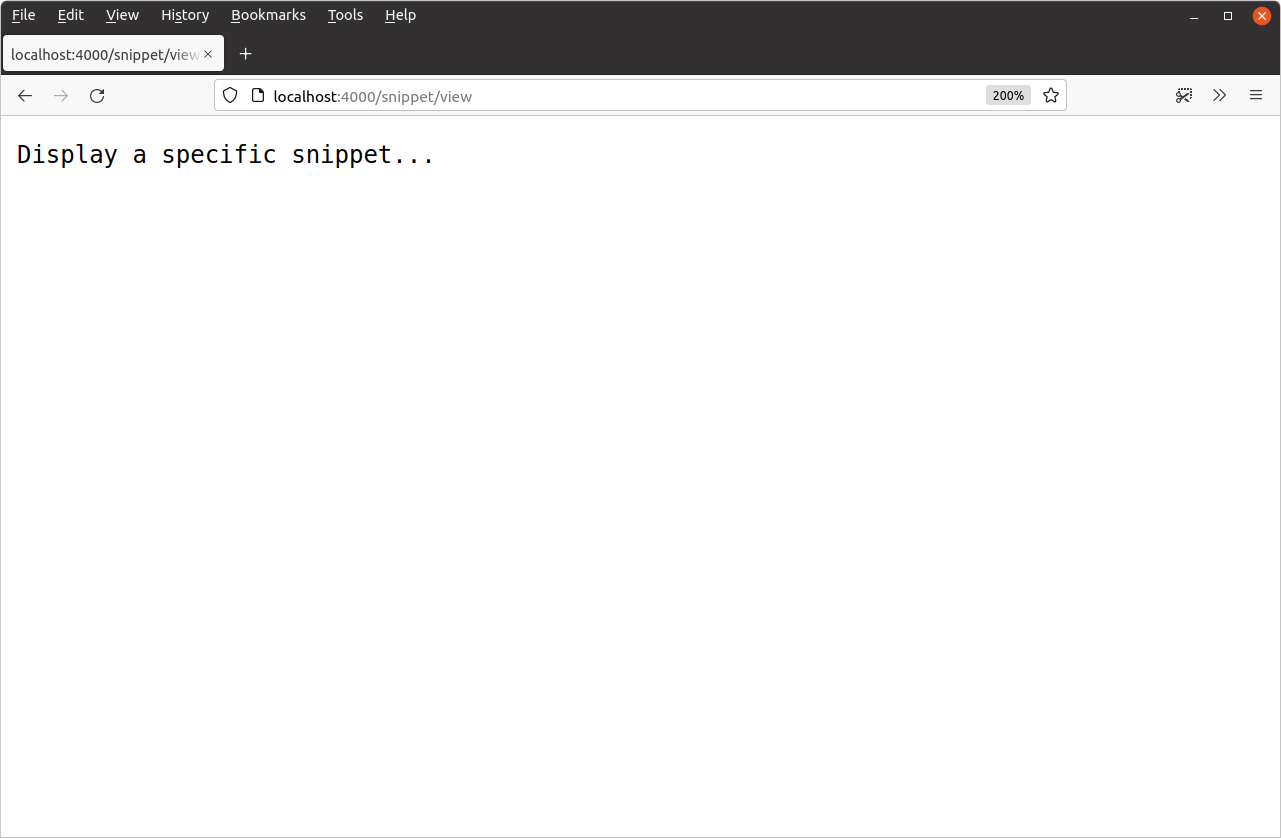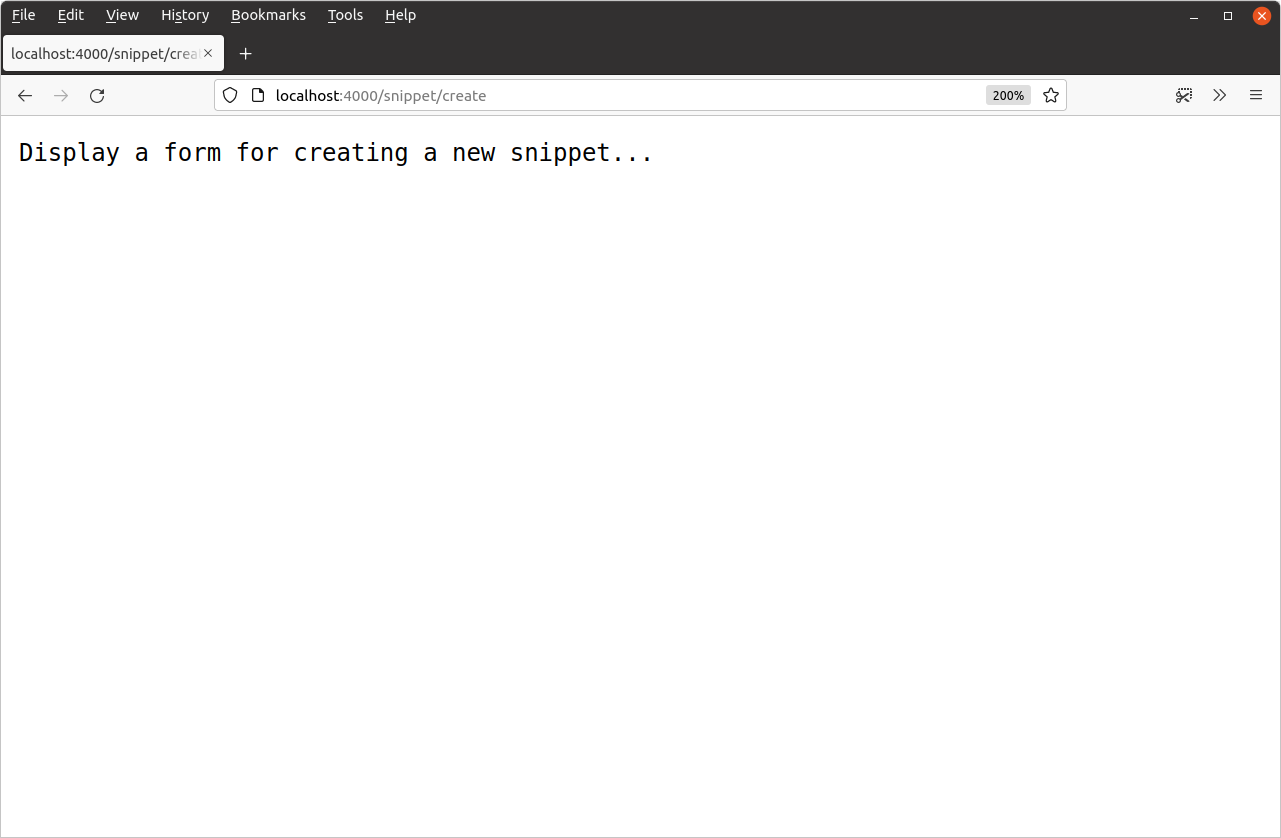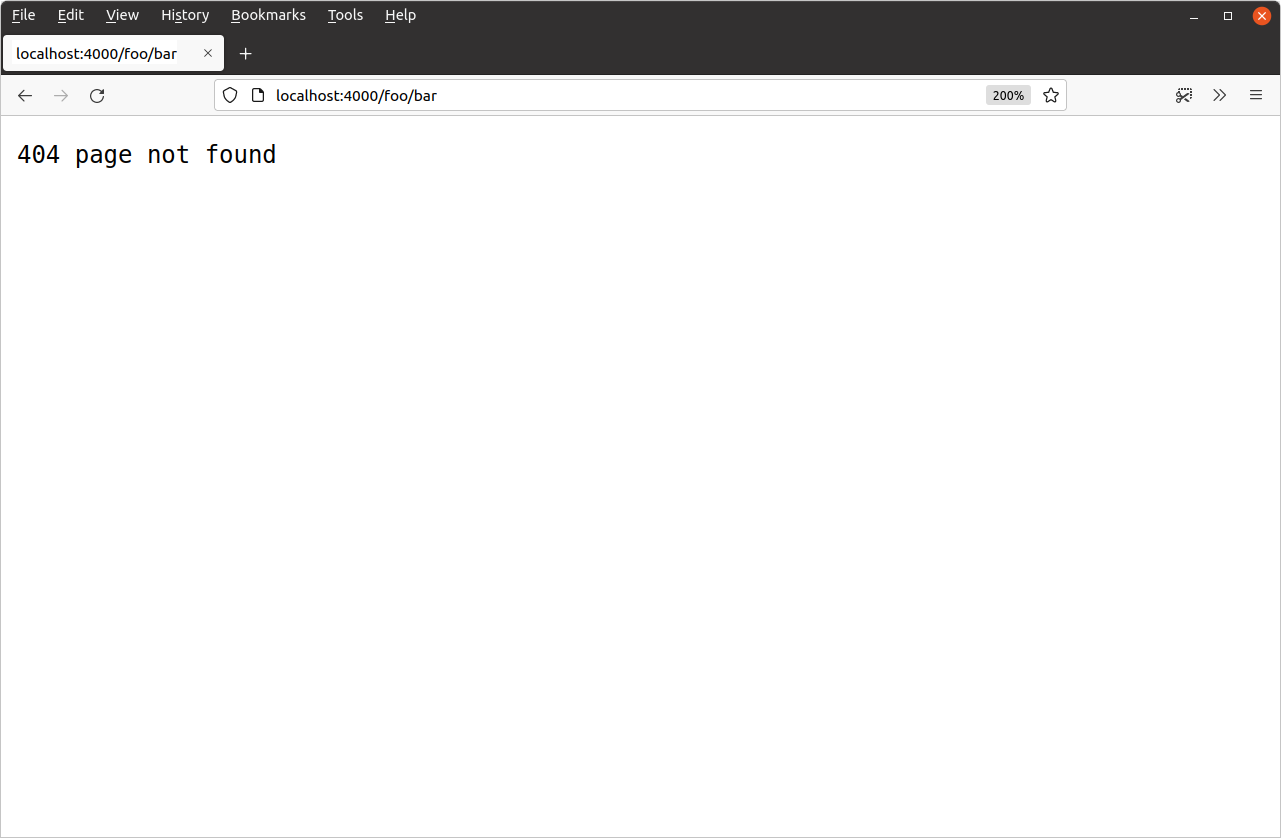Routing requests
Having a web application with just one route isn’t very exciting… or useful! Let’s add a couple more routes so that the application starts to shape up like this:
| Route pattern | Handler | Action |
|---|---|---|
| / | home | Display the home page |
| /snippet/view | snippetView | Display a specific snippet |
| /snippet/create | snippetCreate | Display a form for creating a new snippet |
Reopen the main.go file and update it as follows:
package main import ( "log" "net/http" ) func home(w http.ResponseWriter, r *http.Request) { w.Write([]byte("Hello from Snippetbox")) } // Add a snippetView handler function. func snippetView(w http.ResponseWriter, r *http.Request) { w.Write([]byte("Display a specific snippet...")) } // Add a snippetCreate handler function. func snippetCreate(w http.ResponseWriter, r *http.Request) { w.Write([]byte("Display a form for creating a new snippet...")) } func main() { // Register the two new handler functions and corresponding route patterns with // the servemux, in exactly the same way that we did before. mux := http.NewServeMux() mux.HandleFunc("/", home) mux.HandleFunc("/snippet/view", snippetView) mux.HandleFunc("/snippet/create", snippetCreate) log.Print("starting server on :4000") err := http.ListenAndServe(":4000", mux) log.Fatal(err) }
Make sure these changes are saved, and then restart the web application:
$ cd $HOME/code/snippetbox $ go run . 2024/03/18 11:29:23 starting server on :4000
If you visit the following links in your web browser, you should now get the appropriate response for each route:


Trailing slashes in route patterns
Now that the two new routes are up and running, let’s talk a bit of theory.
It’s important to know that Go’s servemux has different matching rules depending on whether or not a route pattern ends with a trailing slash.
Our two new route patterns — "/snippet/view" and "/snippet/create" — don’t end in a trailing slash. When a pattern doesn’t have a trailing slash, it will only be matched (and the corresponding handler called) when the request URL path exactly matches the pattern in full.
When a route pattern ends with a trailing slash — like "/" or "/static/" — it is known as a subtree path pattern. Subtree path patterns are matched (and the corresponding handler called) whenever the start of a request URL path matches the subtree path. If it helps your understanding, you can think of subtree paths as acting a bit like they have a wildcard at the end, like "/**" or "/static/**".
This helps explain why the "/" route pattern acts like a catch-all. The pattern essentially means match a single slash, followed by anything (or nothing at all).
Restricting subtree paths
To prevent subtree path patterns from acting like they have a wildcard at the end, you can append the special character sequence {$} to the end of the pattern — like "/{$}" or "/static/{$}".
So if you have the route pattern "/{$}", it effectively means match a single slash, followed by nothing else. It will only match requests where the URL path is exactly /.
Let’s use this in our application to stop our home handler acting as a catch all, like so:
package main ... func main() { mux := http.NewServeMux() mux.HandleFunc("/{$}", home) // Restrict this route to exact matches on / only. mux.HandleFunc("/snippet/view", snippetView) mux.HandleFunc("/snippet/create", snippetCreate) log.Print("starting server on :4000") err := http.ListenAndServe(":4000", mux) log.Fatal(err) }
Once you’ve made that change, restart the server and make a request for an unregistered URL path like http://localhost:4000/foo/bar. You should now get a 404 response which looks a bit like this:

Additional information
Additional servemux features
There are a couple of other servemux features worth pointing out:
Request URL paths are automatically sanitized. If the request path contains any
.or..elements or repeated slashes, the user will automatically be redirected to an equivalent clean URL. For example, if a user makes a request to/foo//bar/../baz/./they will automatically be sent a301 Permanent Redirectto/foo/baz/instead.If a subtree path has been registered and a request is received for that subtree path without a trailing slash, then the user will automatically be sent a
301 Permanent Redirectto the subtree path with the slash added. For example, if you have registered the subtree path/foo/, then any request to/foowill be redirected to/foo/.
Host name matching
It’s possible to include host names in your route patterns. This can be useful when you want to redirect all HTTP requests to a canonical URL, or if your application is acting as the back end for multiple sites or services. For example:
mux := http.NewServeMux() mux.HandleFunc("foo.example.org/", fooHandler) mux.HandleFunc("bar.example.org/", barHandler) mux.HandleFunc("/baz", bazHandler)
When it comes to pattern matching, any host-specific patterns will be checked first and if there is a match the request will be dispatched to the corresponding handler. Only when there isn’t a host-specific match found will the non-host-specific patterns also be checked.
The default servemux
If you’ve been working with Go for a while you might have come across the http.Handle() and http.HandleFunc() functions. These allow you to register routes without explicitly declaring a servemux, like this:
func main() { http.HandleFunc("/", home) http.HandleFunc("/snippet/view", snippetView) http.HandleFunc("/snippet/create", snippetCreate) log.Print("starting server on :4000") err := http.ListenAndServe(":4000", nil) log.Fatal(err) }
Behind the scenes, these functions register their routes with something called the default servemux. This is just a regular servemux like we’ve already been using, but which is initialized automatically by Go and stored in the http.DefaultServeMux global variable.
If you pass nil as the second argument to http.ListenAndServe(), the server will use http.DefaultServeMux for routing.
Although this approach can make your code slightly shorter, I don’t recommend it for two reasons:
It’s less explicit and feels more ‘magic’ than declaring and using your own locally-scoped servemux.
Because
http.DefaultServeMuxis a global variable in the standard library, it means any Go code in your project can access it and potentially register a route. If you have a large project codebase (especially one that is being worked on by many people), that can make it harder to ensure all route declarations for your application are easily discoverable in one central place.It also means that any third-party packages that your application imports can register routes with
http.DefaultServeMuxtoo. If one of those third-party packages is compromised, it could potentially usehttp.DefaultServeMuxto expose a malicious handler to the web. It’s simple to avoid this risk by just not usinghttp.DefaultServeMux.
So, for the sake of clarity, maintainability and security, it’s generally a good idea to avoid http.DefaultServeMux and the corresponding helper functions. Use your own locally-scoped servemux instead, like we have been doing in this project so far.